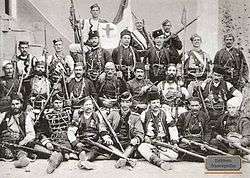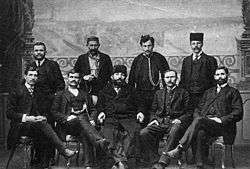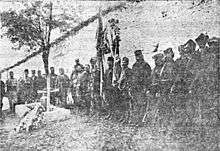Jovan Babunski
| vojvoda Jovan Babunski | |
|---|---|
 | |
| Birth name | Jovan Stojković |
| Nickname(s) | Babunski |
| Born |
25 December 1878 Martolci, Ottoman Empire |
| Died |
17 February 1920 (aged 41) Veles, Kingdom of Serbs, Croats and Slovenes |
| Allegiance |
|
| Years of service | 1905–1920 |
| Rank | vojvoda |
| Battles/wars | |
| Awards |
|
Jovan Stojković (Serbian Cyrillic: Јован Стојковић; 25 December 1878 – 17 February 1920), known as Jovan Babunski (Јован Бабунски), was a Serbian Chetnik commander (Serbian: vojvoda, војвода) during the Macedonian Struggle, Balkan Wars and World War I. Following the murder of his brother and nephew by the Internal Macedonian Revolutionary Organization (IMRO), he joined a Chetnik band and took command of Chetnik units on the Vardar River, where he and his men often engaged Bulgarian and Ottoman forces.
With the outbreak of the First Balkan War he joined the Serbian Army and was wounded while fighting in the village of Strevica. During the Second Balkan War, he joined a Serbian volunteer detachment and fought at the Battle of Bregalnica. During World War I, Babunski and his Chetnik detachment fought Austro-Hungarian forces in the summer of 1914 and later fought on the Salonika Front, where Babunski was ordained by French General Louis Franchet d'Espèrey after he and his men captured two German midget submarines and their crews. After the war, Babunski and his 250-strong force helped Serb authorities suppress Bulgarian resistance in the Macedonian towns of Bitola and Tikveš, committing several atrocities in the process. Considered one of the most famous Chetnik commanders of his time, Babunski died in Veles in February 1920.
Early life
Jovan Stojković was born in the village of Martolci in central Macedonia, at the foot of Mount Babuna, near Veles, on 25 December 1878.[1] In his youth, he was nicknamed "Babunski", by which he was referred to for the rest of his life.[2] He began attending primary school at the age of 10. It was here that his teacher Bulgarianized his name into "Ivan Stoykov". Displeased, Babunski's father took his son to the Serbian consulate in Skopje and requested that his son be transferred to a primary school in Belgrade.[3] Babunski's primary and secondary education took place in Belgrade, Valjevo and Niš. In his twenties, he worked as a School teacher in Tetovo and Veles.[4]
Guerrilla activities


In 1905, Babunski's brother and nephew were killed by the Internal Macedonian Revolutionary Organization (Bulgarian: Вътрешна Македонска Революционна Организация; VMRO).[4] Seeking revenge, he joined the Chetnik band of Gligor Sokolović and Temeljko Barjaktarević. That year, he became a Chetnik vojvoda.[3] Afterwards, he defended the right bank of the Vardar River against Bulgarian insurgents and protected persecuted Serb villages against Bulgarian and Ottoman attacks.[5] This prompted the VMRO to place a bounty of 20,000 leva on his head.[3] Through these actions, Babunski became one of the five leading Serbian guerilla chiefs in Macedonia.[6] Babunski's participation in the struggle against the Ottomans and Bulgarians came at a great personal cost; his wife was tortured in order to disclose his whereabouts and one of his children was killed.[3] With the Young Turk Revolution in 1908, the Ottomans declared a ceasefire between their forces and those of the Chetniks. Babunski left the Chetniks' ranks and returned to civilian life. He was later arrested by the Ottoman authorities, but quickly escaped from prison.[7] That year, he returned to the Serbia.[5]

Babunski fought with the Royal Serbian Army during the First Balkan War and was wounded in a skirmish with Ottoman Turkish forces in the village of Strevica while serving under commander Vojin Popović.[7] During the Second Balkan War, he fought with a Serbian volunteer detachment at the Battle of Bregalnica.[8]
Following the outbreak of World War I, Babunski formed the Sava Chetnik detachment, which was placed under the command of Major Vojislav Tankosić.[9] The unit suffered its first casualties when Austro-Hungarian river monitors shelled Belgrade on the night of 28 July 1914, killing a 16-year-old Chetnik volunteer named Dušan Đonović, the first victim of the war. Shortly afterwards, Babunski's Chetniks destroyed a railway bridge on the Sava to prevent the Austro-Hungarians from crossing.[10] Babunski and his men returned to Macedonia in 1915 and fought Bulgarian guerillas.[11] That autumn Babunski and his Chetniks were assigned to the town of Kačanik, where they joined other Serbian forces in fighting a Bulgarian division that they managed to hold to a standstill for nearly a month despite suffering heavy losses.[12] With the Serbian army's retreat through Albania that winter, Babunski and his men withdrew to the Greek island of Corfu.[13] They then joined Serb forces at the Salonika Front.[4] Here, Babunski was assigned to the Serbian First Army and was involved in guarding Lake Prespa from the Bulgarians.[14] Later, he and his Chetnik detachments participated in capturing enemy soldiers and gathering intelligence from the front.[15] In 1917, French General Louis Franchet d'Espèrey awarded Babunski a medal following the capture of two German midget submarines and their crews by him and his men.[16] Babunski was also a recipient of the Order of the Star of Karađorđe.[17]
Later life and legacy

After the war, Babunski's Chetniks were dispatched to Kosovo and Macedonia,[18] reinforcing the 50,000 soldiers that had been deployed to quell the armed uprisings there.[19] Babunski's force of 250 men helped the authorities suppress resistance in the towns of Bitola and Tikveš,[20] targeting locals sympathetic to the Bulgarian komitas, and committing several atrocities in the process.[21] Forces under his command also committed several atrocities in Albania.[22] Chetnik bands, including those of Babunski, are also said to have enslaved locals and turned them into forced labourers for the armed forces of the Kingdom of Serbs, Croats and Slovenes.[19] By the summer of 1919, the authorities had decided that paramilitary formations such as Babunski's were not "furthering the state's aims in the region".[18] Babunski died in Veles on 17 February 1920, after contracting influenza.[3]
The historian Dušan T. Bataković characterizes Babunski as "exceptionally courageous and determined".[5] John Paul Newman, a historian specializing in Yugoslavia's interwar paramilitary formations, believes Babunski would have become one of the most powerful figures in the interwar Chetnik Association had it not been for his premature demise. Babunski was celebrated as a national hero following his death and featured heavily in veterans' commemorations during the interwar period.[23] A monument dedicated to him was constructed in Veles in 1924, but was destroyed by Bulgarian occupational authorities during World War II, when Macedonia was annexed by Bulgaria following Yugoslavia's dismemberment by the Axis.[5] The nom de guerre Babunski was adopted as a surname by his descendants.[24]
Notes
- ↑ Stanojević 2000, p. 110.
- ↑ Palairet 2016, p. 146.
- 1 2 3 4 5 Great Britain and the Eastern Question 1920, p. 427.
- 1 2 3 Bechev 2009, p. 21.
- 1 2 3 4 Bataković 2005, p. 194.
- ↑ Banac 1984, p. 316.
- 1 2 Pejčić 2007, p. 63.
- ↑ Pejčić 2007, p. 70.
- ↑ Pejčić 2007, p. 74.
- ↑ Lyon 2015, p. 97.
- ↑ Pejčić 2007, pp. 78–79.
- ↑ Pejčić 2007, pp. 82–85.
- ↑ Pejčić 2007, p. 94.
- ↑ Pejčić 2007, p. 123.
- ↑ Pejčić 2007, p. 378.
- ↑ Pejčić 2007, p. 380.
- ↑ Vlahović 1989, p. 274.
- 1 2 Newman 2012, p. 154.
- 1 2 Ramet 2006, p. 47.
- ↑ Bechev 2009, pp. 21–22.
- ↑ Banac 1984, p. 320.
- ↑ Newman 2012, p. 146.
- ↑ Newman 2015, pp. 104–105.
- ↑ Recueil de Vardar. Akademija. 2006. p. 99.
| Wikimedia Commons has media related to Jovan Babunski. |
References
- Banac, Ivo (1984). The National Question in Yugoslavia: Origins, History, Politics. Ithaca, New York: Cornell University Press,. ISBN 978-0-8014-9493-2.
- Bataković, Dušan T., ed. (2005). Histoire du peuple serbe [History of the Serbian People] (in French). Lausanne: L’Age d’Homme.
- Bechev, Dimitar (2009). Historical Dictionary of the Republic of Macedonia. Lanham, Maryland: Rowman & Littlefield. ISBN 978-0-8108-6295-1.
- Brock, Ray (1952). Blood, Oil and Sand. London, England: The Bodley Head.
- Great Britain and the Eastern Question (25 March 1920). "Serbian Sketches". Great Britain and the Eastern Question. Journal of International Relations. 17 (464).
- Lyon, James (2015). Serbia and the Balkan Front, 1914: The Outbreak of the Great War. New York, New York: Bloomsbury Publishing. ISBN 978-1-47258-006-1.
- Newman, John Paul (2012). "Paramilitary Violence in the Balkans". In Gerwarth, Robert; Horne, John. War in Peace: Paramilitary Violence in Europe After the Great War. Oxford, England: Oxford University Press. ISBN 978-0-19-968605-6.
- Newman, John Paul (2015). Yugoslavia in the Shadow of War: Veterans and the Limits of State Building, 1903–1945. Cambridge, England: Cambridge University Press. ISBN 978-1-10707-076-9.
- Palairet, Michael (2016). From the Fifteenth Century to the Present. Macedonia: A Voyage Through History. 2. Cambridge, England: Cambridge University Press. ISBN 978-1-44388-849-3.
- Pejčić, Predrag (2007). Četnički pokret u Kraljevini Srbiji [The Chetnik Movement in the Kingdom of Yugoslavia] (in Serbian). Kragujevac, Serbia: Pogledi. ISBN 978-86-82235-55-2.
- Ramet, Sabrina P. (2006). The Three Yugoslavias: State-Building and Legitimation, 1918–2005. Bloomington, Indiana: Indiana University Press. ISBN 978-0-253-34656-8.
- Stanojević, Stanoje (2000). Narodna enciklopedija: srpsko-hrvatsko-slovenačka [Serb-Croat-Slovenian National Encyclopaedia]. Belgrade, Yugoslavia: Budućnost.
- Vlahović, Tomislav (1989). Vitezovi Karađorđeve zvezde [The Knights of the Star of Karađorđe]. Belgrade, Yugoslavia: Beostar.